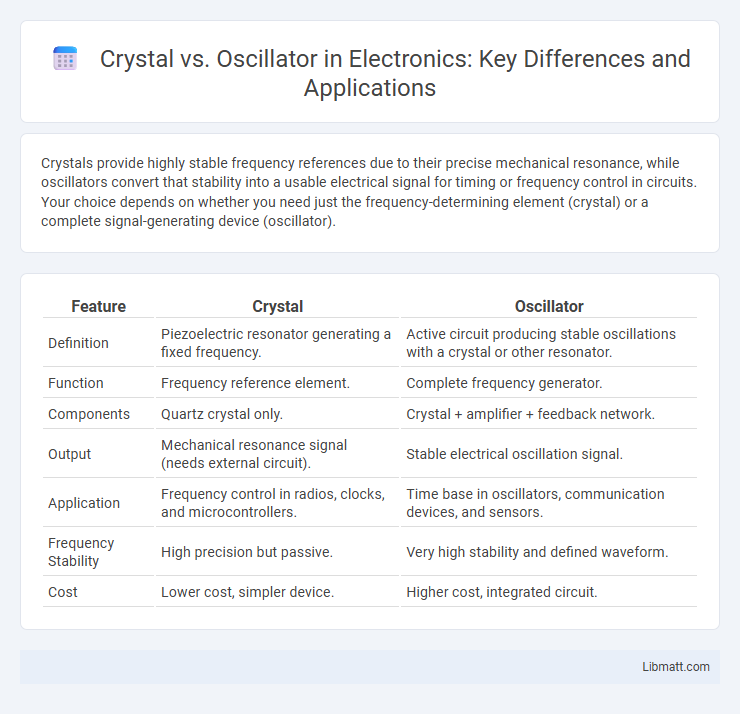Crystals provide highly stable frequency references due to their precise mechanical resonance, while oscillators convert that stability into a usable electrical signal for timing or frequency control in circuits. Your choice depends on whether you need just the frequency-determining element (crystal) or a complete signal-generating device (oscillator).
Table of Comparison
| Feature | Crystal | Oscillator |
|---|---|---|
| Definition | Piezoelectric resonator generating a fixed frequency. | Active circuit producing stable oscillations with a crystal or other resonator. |
| Function | Frequency reference element. | Complete frequency generator. |
| Components | Quartz crystal only. | Crystal + amplifier + feedback network. |
| Output | Mechanical resonance signal (needs external circuit). | Stable electrical oscillation signal. |
| Application | Frequency control in radios, clocks, and microcontrollers. | Time base in oscillators, communication devices, and sensors. |
| Frequency Stability | High precision but passive. | Very high stability and defined waveform. |
| Cost | Lower cost, simpler device. | Higher cost, integrated circuit. |
Introduction to Crystals and Oscillators
Crystals and oscillators are fundamental components in electronic circuits used to generate precise frequency signals. A crystal is a piezoelectric material, typically quartz, that resonates at a specific frequency when voltage is applied, providing high-frequency stability. Oscillators incorporate crystals or other resonators to produce consistent periodic electronic signals essential for clocks, radios, and microcontrollers.
What is a Crystal?
A crystal is a precisely cut piece of quartz used in electronic circuits to regulate frequency through its piezoelectric properties. It generates a stable oscillating signal by vibrating at a specific natural resonant frequency when voltage is applied. Crystals are essential in devices like clocks, radios, and computers for accurate timekeeping and frequency control.
What is an Oscillator?
An oscillator is an electronic circuit that generates a repetitive, oscillating signal, commonly in the form of a sine wave or square wave, crucial for timing and frequency control in electronic devices. Crystal oscillators use a quartz crystal to stabilize the frequency, providing high precision and low phase noise, making them ideal for clocks, radios, and communication systems. You rely on oscillators for accurate signal generation, where the choice between a crystal or other types depends on the required frequency stability and application.
Key Differences between Crystals and Oscillators
Crystals are passive components that rely on piezoelectric properties to generate a precise frequency when an external circuit drives them, whereas oscillators are active circuits that incorporate crystals or resonators to produce stable and consistent oscillating signals. Crystals offer high frequency stability and accuracy but require additional circuitry to function, while oscillators provide a complete solution with built-in amplification, making them easier to implement in electronic devices. The choice between a crystal and an oscillator depends on design complexity, space constraints, and the need for integrated frequency generation.
Applications of Crystals in Electronics
Crystals are widely used in electronics for precise frequency control in devices such as watches, radios, and smartphones, ensuring stable oscillation and timing accuracy. Quartz crystals serve as essential components in microprocessors and communication systems, providing reliable clock signals for synchronization. Their high Q factor and temperature stability make them ideal for filters and frequency references in RF circuits and signal processing equipment.
Applications of Oscillators in Electronics
Oscillators play a crucial role in electronics by generating continuous waveforms essential for clocks in microprocessors, signal generators, and communication devices such as radios and smartphones. Crystal oscillators provide highly stable and precise frequency references used in GPS systems, digital watches, and medical equipment. Your electronic designs benefit from selecting oscillators that balance frequency stability, size, and power consumption for optimized performance.
Performance Factors: Stability, Accuracy, and Noise
Crystal oscillators provide superior frequency stability and accuracy compared to mechanical oscillators due to their precise piezoelectric properties. Noise levels in crystal oscillators are significantly lower, resulting in cleaner signal generation ideal for applications requiring high precision and minimal phase jitter. Selecting the right oscillator influences your system's overall timing performance by balancing these critical factors.
Choosing Between Crystal and Oscillator
Choosing between a crystal and an oscillator depends on application requirements such as frequency accuracy, stability, and integration level. Crystals provide precise frequency control with low phase noise but require external circuitry for oscillation, making them ideal for custom designs. Oscillators offer integrated frequency generation and easy implementation, preferred in systems demanding compactness and simplified design.
Pros and Cons: Crystal vs Oscillator
Crystals offer superior frequency stability and low phase noise, making them ideal for precise timing applications, but they can be fragile and more sensitive to temperature variations. Oscillators provide integrated frequency generation with wider output options and better resistance to environmental changes, though they often consume more power and have slightly less accuracy compared to standalone crystals. Your choice depends on whether accuracy or integration and durability are the priority in your design.
Future Trends in Frequency Control Devices
Future trends in frequency control devices emphasize the integration of microelectromechanical systems (MEMS) oscillators, which offer improved robustness, miniaturization, and lower power consumption compared to traditional quartz crystals. Advancements in silicon-based resonators and temperature-compensated MEMS technology contribute to enhanced frequency stability and environmental resilience for applications in 5G, IoT, and automotive industries. The shift towards digital synthesis techniques combined with these emerging oscillators enables higher precision timing solutions critical for next-generation communication and sensor systems.
Crystal vs Oscillator Infographic

 libmatt.com
libmatt.com